AN AFTERNOON OF COLONIAL LIFE
Hearth Cooking and Colorful Docents Mark Historic Society's Family Fun Day 2001
By Hoag Levins ...| ...April 30, 2001
CAMDEN, N.J. -- There is something almost spiritual about shifting yourself into an eighteenth-century state of mind for the day, said Beth Beatty.
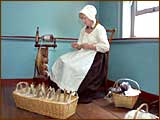
|
| Photo: Hoag Levins. |
|
Beth Beatty demonstrated spinning.
|
|
Barefoot and wearing homespun garb, the Cherry Hill woman was arranging baskets of raw wool around her spinning wheel as she greeted the first visitors to the third annual Family Fun Day at Pomona Hall on the eastern edge of the city.
Beatty's sentiments seemed to echo the essence of the event itself -- an afternoon that pointedly ignored the world of computers and interactive virtual reality for a quieter, hands-on engagement with the skills and daily realities of colonial life.
Sponsored by the Camden County Historical Society (CCHS), yesterday's Family Fun Day was graced with brilliant sunshine and a crowd enthralled by living history interpreters.
Original concept
"We started this three years ago as a way to get more people involved with us," said Joanne Seitter, a librarian who heads up CCHS's membership drive. "We really wanted to do something adults and children would enjoy together and want to tell their friends about. This year we have almost twice the number of people who were here last year, and last year we had twice the number of people who were here the first year, so it seems to be working."
And, she noted, most of this year's new attendees had never before been to any CCHS event.
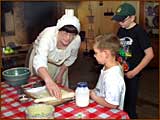
|
| Photo: Hoag Levins. |
|
Hazel Werner shows hearth helpers how to roll cookie dough.
|
|
The free day included open-hearth cooking, Victorian hoop games, the spinner who turned clumps of wool into smooth strands of yarn, and an activities room where visitors could try their hand at writing with quills and ink pots.
Open-hearth cooking
Most distinctive of all activities was the open-hearth cooking that filled the three-building sprawl of the CCHS complex -- colonial mansion, library and two-story museum -- with the evocative aromas of old-fashioned cornbread and cinnamon apple crisp baking over wood fires.
The huge eighteenth-century kitchen has a stone fireplace so large the two cooks walked in and out of it like a room. Roaring wood fires were banked down to piles of carefully tended glowing coals beneath iron pots of beans, pans of potatoes and tins of bread.
Performers as well as chefs accomplished with the old tools and techniques, Betty Schopp of Riverton and Hazel Werner of Medford
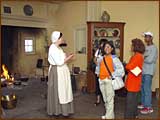
|
| Photo: Hoag Levins. |
|
Visitors tour Pomona Hall's huge open-hearth kitchen.
|
|
bustled about, kneading dough, beating batter, tending coals and serving samples at the same time they answered a constant stream of visitors' questions about their craft.
'Perfect job'
"I have always loved to cook and I love history, so the two combined into a perfect job," said Werner, who started as colonial hearth cook at a Louisville, Kentucky, historic house nine years ago.
At a nearby table, she invited youngsters to use needles and thread to string beans for drying and work a miniature churn making real butter.
Upstairs on the second floor of Pomona Hall, the mansion from which the Cooper family once ran a 400-acre colonial farm now covered by parts of Collingswood and Camden, Susan McNaughton was passing out white feather quill pens and waving around hornbooks.
McNaughton, of Cherry Hill, designed and runs CCHS's "Colonial Life" education programs.
"At first, the kids all say they'd rather write with the quills than a pencil," said McNaughton, a former fifth-grade teacher.
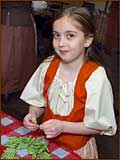
|
| Photo: Hoag Levins. |
|
A young docent shows how beans were strung and preserved.
|
|
"But when they actually try it, they realize that they can't erase and that there is something of an art to the use of a quill pen. It's a little messy, but they have a lot of fun and gain new insights into what it was like for the Coopers of the 1700s."
Scattered about the room on other tables are things such as corn husk dolls, spring-loaded candle holders, cones of white and brown sugar as hard as plaster and a rock-like lump of what is really old-time soap.
Hands-on artifacts
"The artifacts are really important," said McNaughton. "We want to children to handle them and try to imagine what life was like before our computer-and-TV society."
There were also lessons of the actual crafts involved in making such items. "Children light up with new understanding when you tell them the corn husk doll they're holding demonstrates how colonial people were the first recyclers," said McNaughton. "Back then, they could not afford to throw anything away: in the case of corn, the kernels were eaten, the husks were fashioned into dolls and the cobs were turned into other useful objects."
Guarding household flame
"Kids today have a hard time visualizing what it was like in an age when
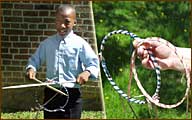
|
| Photo: Hoag Levins. |
|
Andre Davis, 9, shows how the frisbee-like Victorian hoop game of 'Graces' was played.
|
|
the daily overriding concern of a household was not to let all its fires go out," said McNaughton brandishing a small bellows. "Some are amazed to learn that matches weren't available until about 1830, and that starting a fire was very difficult. The goal was to always have one fire still burning so it could be used to light whatever others were required."
Another question she asks the children is what would they have taken with them if they were scheduled to sail on the Mayflower in 1620 and hoped to survive the first year in the forests and wild shores of the new world.
"Some make a list like 'batteries, CD player, GameBoy'," said McNaughton, chuckling and smacking her forehead. "I tell them, 'You're going to die!' and get them to understand why the most important items for their lists should be things like fish hooks and nets and buckets."
Horn books
Each child at Family Fun Day also got a replica of a "horn book," which was one of the earliest
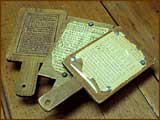
|
| Photo: Hoag Levins. |
|
Reproductions of colonial-era horn books.
|
|
schooling tools in the colonies. The originals consisted of a piece of wood with a handle, shaped something like a modern-day hand mirror. They contained a single sheet of paper -- a substance that was then handmade, expensive and difficult to obtain. Densely printed on that single sheet of paper were fundamental fact sets, like the alphabet or biblical passages. To protect the paper, it was covered with a translucent sheet made from ground-up animal horn, hence the name 'horn book.'
"In one sense," said McNaughton, "it's a good way to teach kids about how, for most people back in colonial times, there were no books, no chalkboards and no teachers, per se, no school buildings."
"At the same time," she continued, "there's an important modern-day lesson in these artifacts -- I show them a photo of children Africa who are still using horn books because that's all there is in that poor country. It helps them see that everyone on Earth does not enjoy the American standard of living."
| 




